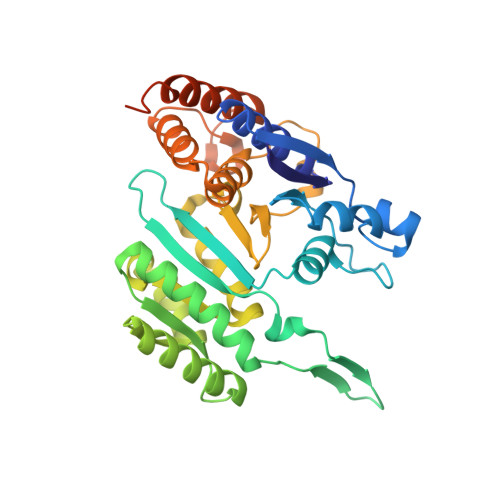Structure and function of an ancestral-type beta-decarboxylating dehydrogenase from Thermococcus kodakarensis
Shimizu, T., Yin, L., Yoshida, A., Yokooji, Y., Hachisuka, S.I., Sato, T., Tomita, T., Nishida, H., Atomi, H., Kuzuyama, T., Nishiyama, M.(2017) Biochem J 474: 105-122
- PubMed: 27831491
- DOI: https://doi.org/10.1042/BCJ20160699
- Primary Citation of Related Structures:
5HN3, 5HN4, 5HN5, 5HN6 - PubMed Abstract:
β-Decarboxylating dehydrogenases, which are involved in central metabolism, are considered to have diverged from a common ancestor with broad substrate specificity. In a molecular phylogenetic analysis of 183 β-decarboxylating dehydrogenase homologs from 84 species, TK0280 from Thermococcus kodakarensis was selected as a candidate for an ancestral-type β-decarboxylating dehydrogenase. The biochemical characterization of recombinant TK0280 revealed that the enzyme exhibited dehydrogenase activities toward homoisocitrate, isocitrate, and 3-isopropylmalate, which correspond to key reactions involved in the lysine biosynthetic pathway, tricarboxylic acid cycle, and leucine biosynthetic pathway, respectively. In T. kodakarensis, the growth characteristics of the KUW1 host strain and a TK0280 deletion strain suggested that TK0280 is involved in lysine biosynthesis in this archaeon. On the other hand, gene complementation analyses using Thermus thermophilus as a host revealed that TK0280 functions as both an isocitrate dehydrogenase and homoisocitrate dehydrogenase in this organism, but not as a 3-isopropylmalate dehydrogenase, most probably reflecting its low catalytic efficiency toward 3-isopropylmalate. A crystallographic study on TK0280 binding each substrate indicated that Thr71 and Ser80 played important roles in the recognition of homoisocitrate and isocitrate while the hydrophobic region consisting of Ile82 and Leu83 was responsible for the recognition of 3-isopropylmalate. These analyses also suggested the importance of a water-mediated hydrogen bond network for the stabilization of the β3-α4 loop, including the Thr71 residue, with respect to the promiscuity of the substrate specificity of TK0280.
Organizational Affiliation:
Biotechnology Research Center, The University of Tokyo, 1-1-1 Yayoi, Bunkyo-ku, Tokyo 113-8657, Japan.

















